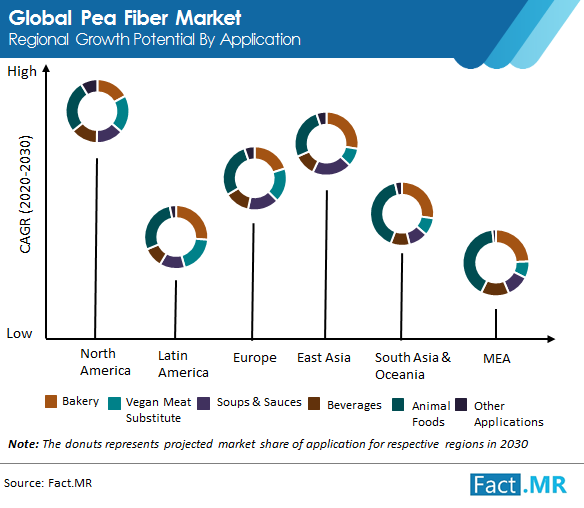
Pea fiber is a byproduct which is extracted from the seeds and pods of a pea plant. The ingredient is used in a variety of vegan items in addition to processed ready to eat meals. Pea fiber comprises high levels of protein, and does not contain any cholesterol either. Consequently pea fiber is expected to gain traction around the world.
Its nutritive properties has made pea fiber an increasingly popular ingredient in a number of pharmaceutical and food products. The global pea fiber market is expected to grow at a strong CAGR of approximately 8 per cent through the forecast period till 2030. The consumption of pea fiber has been found to reduce the risk of cancer, which has made is a popular option in nutrition supplements.
Pea fiber has also been found to reduce body fat for obese people. In addition pea fiber is a non-GMO, clean label, and 100 per cent natural ingredient, which is expected to substantially bolster its adoption in end use industry, with strong growth coming out of the food industry.
Request for Sample Report with Statistical Info @ https://www.factmr.com/connectus/sample?flag=S&rep_id=4312

Pelletization and Backward Integration are Key Strategies
The global market of pea fiber is largely consolidated in nature and a major share in terms of pea fiber is from major names such as Quadra Chemicals, Roquette Freres, Cosucra, Emsland Group, and Puris Proteins.
Such major pea fiber producers are boosting their revenue through the use of new extraction and drying processes, with the aim of bolstering production capacities. The rapid recent increase in the use of pea protein for animal feed has also resulted in manufacturers adopting the practice of palletization, which will help in easing out handling cost through cost effective transportation. In addition, the process increases product safety, easier handling and lesser dust.
Further, major producers are also making use of backward integration to boost productivity. The process involves the use of non-GMO seeds to product manufacturers for high quality raw materials, and better vertical integration and taste of pea co products. The use of backward integration gives producers better control over value chains, which will increase efficiency had help in keeping up competitiveness.
Popularity of Veganism Creates Lucrative Opportunities
Major players in the vegan food industry are driving the adoption of plant based foods on the basis of the product portfolio. Further, the demand for a higher dietary fiber intake, which will contribute to the growth of the pea fiber industry. The demand for pea fiber in the animal feed industry is also set to go up with the rising requirements for meat and milk products.
Request to Browse Report Customization @ https://www.factmr.com/connectus/sample?flag=RC&rep_id=4312
On the other hand, pea fiber is comparatively expensive, and cheaper alternatives such as chickpeas, lentils, and kidney beans are easily available. These factors are playing a substantial role in hindering the global growth of the pea fiber market. The demand for pea fiber will rise despite this owing to the high demand for fiber additives and meat extenders, which is expected to continue throughout the forecast period.
About Fact.MR
Fact.MR is a fast-growing market research firm that offers the most comprehensive suite of syndicated and customized market research reports. We believe transformative intelligence can educate and inspire businesses to make smarter decisions. We know the limitations of the one-size-fits-all approach; that’s why we publish multi-industry global, regional, and country-specific research reports.
Media Release: https://www.factmr.com/media-release/1134/global-pea-fiber-market



























